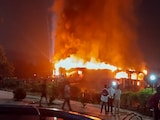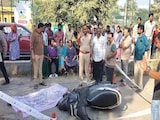Amidst Diwali celebrations, the skies light up but so do pollution charts. As a way to make Diwali celebrations healthier for us and the environment, the concept the Green Diwali has emerged. The term refers to celebrating the festival of lights in an environmentally friendly, low-pollution way. The aim with Green Diwali is to avoid firecrackers, go for ‘green crackers' and burn firecrackers at permitted times. Along with this, Green Diwali encourages us to opt for natural, biodegradable decor like organic rangoli, earthen lamps and flower petals. And at last, reduce general waste and minimise noise, light and air pollution. In a sense, Green Diwali urges us to focus on the beauty of the festival which is togetherness, light and rituals and reduce environmental damage.
Why Do We Need Green Diwali?
The festive burst of crackers does more than just dazzle, it enormously spikes air pollution levels. Here are some stats:
- One multi-city study by Springer between 2019-22 showed that PM₂.₅ and PM₁₀ levels rise sharply during and after Diwali compared to pre-Diwali baseline.
- In a coastal Indian city study (Bhavnagar), airborne heavy metals, sulphur dioxide nitrogen dioxide, volatile compounds all showed distinct post-Diwali spikes.
- A source-apportionment study in Delhi found that during Diwali, fireworks accounted for around 95% of elemental PM₂.₅ in the air, and many toxic trace metals like As, Ba, Sr, etc. spiked massively.
- Short-term rises in respiratory distress, asthma exacerbations, hospital visits for lung issues are documented.
- Fine particles (PM₂.₅) penetrate deep into the lungs and bloodstream that has been found to aggravate lung disease, cardiovascular disease, and even contribute to long-term damage.
Considering these factors it is safe to say, Green Diwali is not just a trend but the need of the hour. Now, that you understand the need for a Green Diwali, let's discuss some ways to encourage it and the benefits.
But first, we must uncover the most crucial aspect of Green Diwali, ‘green crackers'.
Green Firecrackers: Are They Actually Better?
The Goal
According to a West Bengal Pollution Control Board FAQ, ‘green crackers' are fireworks redesigned with the following features in mind:
- Reduction in shell size
- Elimination or reduction of ash-forming ingredients
- Use of additives or ‘dust suppressants'
- Targeted reduction in particulate emissions (minimum ~30%) and gaseous pollutants like NO₂ and SO₂.
- Less use of barium nitrate used traditionally to produce green flame and other heavy metals. use of alternative oxidisers and better combustion additives.
The Benefits
- A study specifically on reduced-emission crackers showed that by modifying formulas (less barium, additives), barium levels in the resultant particulate emissions drop.
- Many reports and policy documents cite around 30% reduction in PM emissions (or somewhat more in controlled settings) as a benchmark for green crackers.
- The concept also includes lower noise levels in some formulations.
The Caveat
- A detailed analysis by Environmental Modelling journal flagged that green crackers emit more ultrafine particles (very small diameter) compared to traditional crackers and these are harder to filter and more hazardous biologically.
- Another paper pointed out that, even if emissions per cracker drop around 30%, in real life people may burst many more crackers because they feel “safe”, offsetting gains.
- A “greenwashing” critique warns that the marketing of green crackers may oversell their benefits.
- Analytical studies of green crackers via spectroscopy still detect toxic metals like Al, Ba, Cu, Sr, Cr in their emissions albeit in lower amounts than regular crackers.
So yes, green crackers are somewhat better, but not harmless. And their real-world effectiveness depends heavily on usage, enforcement and awareness. Beyond ‘green crackers' other environmental efforts might help reduce the pollution-oriented impact of Diwali. Below are some factors to consider.
Beyond Green Crackers: Your Eco-Friendly Diwali Hacks
If you really want to celebrate a Diwali that is eco-friendly and rooted in the things that matter, then crackers should be your last resort. Besides crackers, here are some other ways to make your Diwali greener:
1. Organic Rangoli
- Avoid synthetic rangoli colours as the dyes often leech onto soil or wash into drains and increase chemical exposure. This also keeps it safe for children and pets.
- Instead, go for organic rangoli which is readily available. It can also be made at home by using rice flour, turmeric, dried flower petals, crushed leaves, coloured sand from clay, etc.
- You can also decorate a “living rangoli” which can be made from potted plants placed in an aesthetic manner or plants planted in a shape of a rangoli figure.
2. Earthen Lamps
- Avoid heavy metal-infused light decorations or battery lamps as these lead to unnecessary electricity wastage and are low-impact.
- Instead, go for clay, terracotta or cow-dung lamps (diyas). These burn with pure ghee or oil and leave minimal residue.
3. Electric Lights
- If you must invest in electricity-running lights, use solar fairy lights (which run on solar energy and are battery-free), LED bulbs and string decorations.
- These help avoid continuous burning of combustible materials.
4. Organic And Reused Decor
- Skip plastic poppers and other decorative options and reach for biodegradable counterparts such as paper-made confetti.
- To go an extra mile, you can avoid use of paper-made decorations (which are biodegradable but strain the environment) and instead make decorations like confetti from old magazines, newspapers and documents that are no longer of any use.
- Opt for dried or fresh flowers for decoration instead of faux flowers often made from non-biodegradable materials.
Yes, Green Diwali has promise. However, is it as safe as we think? Here are some precautions to keep in mind.
Eco-Friendly Diwali: Precautions To Keep In Mind
- Check authenticity: Only use crackers bearing the CSIR-NEERI / PESO “green cracker” logo and valid QR codes. Avoid suspicious packaging.
- Limit time & volume: Avoid prolonged or repeated bursts. Even green ones accumulate pollution if many are lit.
- Stay downwind: Don't stand where smoke is blowing at you.
- Distance & protective gear: Use gloves, goggles, masks if you must handle crackers.
- Don't reuse dud crackers.
- Disposal: Soak burnt remnants in water before throwing them away.
- Vulnerable groups: Children, elderly, persons with asthma or heart disease, it's better to avoid exposure altogether during and right after bursting.
- Ventilation & indoor air: Keep windows open or on positive ventilation to avoid indoor smoke build-up.
What's The Takeaway?
Green Diwali is not a silver bullet but a step in the right direction. Opt for eco-friendly decor, avoid using firecrackers and encourage strong public awareness. Perform responsible public behaviour and do proper research, don't opt for products simply because they claim to me “green.” Stay safe and enjoy with your loved ones, Happy Diwali!
Disclaimer: This content including advice provides generic information only. It is in no way a substitute for a qualified medical opinion. Always consult a specialist or your doctor for more information. NDTV does not claim responsibility for this information.
References
“Green firecrackers' with reduced barium emissions in particulate…” — NCBI (2022)
“Pre-to-post Diwali air quality assessment and particulate matter…” — NCBI (2023)
“Trends of air pollution variations during pre-Diwali, Diwali & post-Diwali” — Springer (2024)
“Assessment of ambient air quality … Jodhpur city” — Jamal et al. (2024)
“Personal exposures to particulate matter <2.5 μm … burning of firecrackers” — NCBI (2019)
“Health-impact assessment of fire crackers, 2017” — Central Pollution Control Board / Government of India report
“Evaluation of analytical techniques for toxic elements in pyrotechnic (green crackers)” — arXiv (2022)















